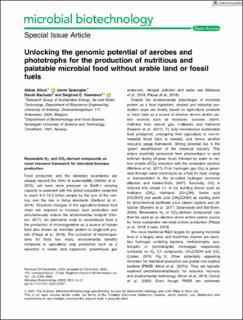Unlocking the genomic potential of aerobes and phototrophs for the production of nutritious and palatable microbial food without arable land or fossil fuels
| dc.contributor.author | Alloul, Abbas | |
| dc.contributor.author | Spanoghe, Janne | |
| dc.contributor.author | Machado, Daniel | |
| dc.contributor.author | Vlaeminck, Siegfried E. | |
| dc.date.accessioned | 2022-12-06T07:18:48Z | |
| dc.date.available | 2022-12-06T07:18:48Z | |
| dc.date.created | 2021-11-10T08:50:11Z | |
| dc.date.issued | 2021 | |
| dc.identifier.citation | Microbial Biotechnology. 2021, . | en_US |
| dc.identifier.issn | 1751-7907 | |
| dc.identifier.uri | https://hdl.handle.net/11250/3035943 | |
| dc.description.abstract | The increasing world population and living standards urgently necessitate the transition towards a sustainable food system. One solution is microbial protein, i.e. using microbial biomass as alternative protein source for human nutrition, particularly based on renewable electron and carbon sources that do not require arable land. Upcoming green electrification and carbon capture initiatives enable this, yielding new routes to H2, CO2 and CO2-derived compounds like methane, methanol, formic- and acetic acid. Aerobic hydrogenotrophs, methylotrophs, acetotrophs and microalgae are the usual suspects for nutritious and palatable biomass production on these compounds. Interestingly, these compounds are largely un(der)explored for purple non-sulfur bacteria, even though these microbes may be suitable for growing aerobically and phototrophically on these substrates. Currently, selecting the best strains, metabolisms and cultivation conditions for nutritious and palatable microbial food mainly starts from empirical growth experiments, and mostly does not stretch beyond bulk protein. We propose a more target-driven and efficient approach starting from the genome-embedded potential to tuning towards, for instance, essential amino- and fatty acids, vitamins, taste,... Genome-scale metabolic models combined with flux balance analysis will facilitate this, narrowing down experimental variations and enabling to get the most out of the ‘best’ combinations of strain and electron and carbon sources. | en_US |
| dc.language.iso | eng | en_US |
| dc.publisher | Society for Applied Microbiology and John Wiley & Sons Ltd. | en_US |
| dc.rights | Navngivelse 4.0 Internasjonal | * |
| dc.rights.uri | http://creativecommons.org/licenses/by/4.0/deed.no | * |
| dc.title | Unlocking the genomic potential of aerobes and phototrophs for the production of nutritious and palatable microbial food without arable land or fossil fuels | en_US |
| dc.title.alternative | Unlocking the genomic potential of aerobes and phototrophs for the production of nutritious and palatable microbial food without arable land or fossil fuels | en_US |
| dc.type | Peer reviewed | en_US |
| dc.type | Journal article | en_US |
| dc.description.version | publishedVersion | en_US |
| dc.source.pagenumber | 6-12 | en_US |
| dc.source.volume | 15 | en_US |
| dc.source.journal | Microbial Biotechnology | en_US |
| dc.source.issue | 1 | en_US |
| dc.identifier.doi | 10.1111/1751-7915.13747 | |
| dc.identifier.cristin | 1953007 | |
| cristin.ispublished | true | |
| cristin.fulltext | original | |
| cristin.qualitycode | 1 |

